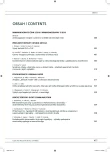The Impact of Pre-operative Time Interval on the Treatment of Discogenic Cauda Equina Syndrome
Authors:
I. Lukáč; I. J. Šulla
Authors‘ workplace:
Neurochirurgická klinika LF UPJŠ a FNLP Košice
Published in:
Cesk Slov Neurol N 2010; 73/106(5): 523-528
Category:
Original Paper
Overview
Cauda equina syndrome (CES) is disease that occurs predominantly in people of productive age, frequently involving serious consequences. The authors evaluated a group of 101 patients treated for CES over a period of 12 years (1996–2007) and followed the dynamics of the development of symptoms in terms of etiology. At a minimum of one year after the completion of treatment (when the condition of the patients was stable), all subjects were invited for checkup examination. Correlations were established between the influence of the pre-operative time interval, i.e. the period between the onset of disease and surgical decompression of neural structures, and the persistence of pain, the restoration of sensitivity and re-establishment of sphincter function. Based on data derived from a group of 68 patients (from a total of 101) with discogenic CES, those who presented for checkup or returned a questionnaire, and statistical analyses (χ2 test, and in situations with values of 5 or less, Fisher exact test) the authors concluded that preoperative time interval had no influence on the outcomes for patients in the group studied. It is interesting to note that preoperative time interval was dependent on the etiology of CES – it was at its shortest in the patients with free sequester or large pieces of intervertebral disc sequesters herniated into the spinal canal. Symptoms of CES arising out of spinal stenosis developed more slowly. The slowest development of symptoms was observed in patients with CES caused by neoplasms.
Key words:
cauda equina syndrome – operation timing
Sources
1. Šulla I, Balík V, Výrostko J. Platničkový syndrom cauda equina a jeho vplyv na pracovnú schopnosť. Praktická medicína 2008; 2(3): 32–34.
2. Tandon PN, Sankaran B. Caudae equina syndrome due to lumbar disc prolapse. Indian J Orthop l967; l: 112–119.
3. Spännare BJ. Prolapsed lumbar intervertebral disc with partial or total occlusion of the spinal canal. A study of 30 patients with and 28 without cauda equina symptoms. Acta Neurochir (Wien) 1978; 65(3–4): 189–198.
4. Šulla IJ, Lukáč I, Šulla I jr. Syndroma caudae equinae discogenes. 1st ed. Košice: UPJŠ 2009.
5. Olmarker K, Rydevik B, Nordborg C. Autologous nucleus pulposus induces neurophysiologic and histologic changes in porcine cauda equina nerve roots. Spine 1993; 18(11): 1425–1432.
6. Orendácová J, Cízková D, Kafka J, Lukácová N, Marsala M, Sulla I et al. Cauda equina syndrome. Prog Neurobiol 2001; 64(6): 613–637.
7. Delamarter RB, Bohlmann HH, Bodner D, Biro C. Neurologic function after experimental cauda equina compression: cystometrograms versus cortical evoked potentials. Spine 1990; 15(9): 864–870.
8. Olmarker K, Rydevik B. Single- versus double-level nerve root compression. An experimental study on the porcine cauda equina with analyses of nerve impulse conduction properties. Clin Orthop 1992; 279: 35–39.
9. Mao GP, Konno S, Arai I, Olmarker K, Kukusi S. Chronic double-level cauda equina compression. An experimental study on the dog cauda equina with analyses of nerve conduction velocity. Spine 1998; 23(15): 1641–1644.
10. Kafka J, Lukáčová N, Čížková D, Maršala J. Zmeny v aktifite syntázy oxidu dusnatého v mieche po ligácii koreňov cauda equina v experimente. Cesk Slov Neurol N 2007; 70/103(5): 505–511.
11. Šulla I jr, Vanický I, Danko J. An attempt at an explanation of unsatisfactory outcomes after operation for cauda equina syndrome. Experimental study. Acta Spondylologica 2004; 2: 44–48.
12. Todd NV. Cauda equina syndrome: the timing of surgery probably does influence outcome. Br J Neurosurg 2005; 19(4): 301–306.
13. Sayegh FE, Kapetanos GA, Symeonides PP, Anogiannakis G, Madentzidis M. Functional outcome after experimental cauda equina compression. J Bone Joint Surg 1997; 79(4): 670–674.
14. Stephenson GC, Gibson RM, Sontag VKH. Who is to blame for the morbidity of acute cauda equina compression? J Neurol Neurosurg Psychiatry 1994; 57: 388.
15. Dyck POJ, Thomas PK, Lambert EH, Bunge R. Peripheral neuropathy. 2nd ed. Philadelphia: WB Saunders 1984.
16. Greenberg MS. Handbook of Neurosurgery. 5th ed. New York: Thieme 2001.
17. Caputo LA, Cusimano MD. Atypical presentation of cauda equina syndrome. J Can Chiropr Assoc 2002; 46(1): 36–38.
18. Olmarker K, Rydevik B, Holm S, Bagge U. Effects of experimental graded compresion on blood flow in spinal nerve roots. A vital microscopic study on the porcine cauda equina. J Orthop Res 1989; 7(6): 817–823.
19. Franson RC, Saal JS, Saal JF. Human disc phospholipase A2 is inflamatory. Spine 1992; 17 (Suppl 6): S129–S132.
20. Kawakami M, Tamaki T. Morphlologic and quantitative changes in neurotransmitters in the lumbar spinal cord after acute or chronic mechanical compression of the cauda equina. Spine 1992; 17 (Suppl 3): S13–S17.
21. Marsala J, Sulla I, Santa M, Marsala M, Mechírová E, Jalc P. Early neurohistological changes of canine lumbosacral spinal cord segments in ischemia-reperfusion induced paraplegia. Neurosci Lett 1989; 106(1–2): 83–88.
22. DeLong WB, Polissar N, Neradilek B. Timing of surgery in cauda equina syndrome with Urinary retention: meta analysis of observational studies. J Neurosurg Spine 2008; 8(4): 305–320.
23. Lukáč I. Syndroma caudae equinae. Košice: LF UPJŠ 2009.
24. Gajdoš M, Leško J, Cicholesová T. Ochorenia driekovej chrbtice – 1. časť: všeobecné poznámky, klinika, diagnostika, konzervatívna liečba. Praktická medicína 2008; 2(3): 30–31.
Labels
Paediatric neurology Neurosurgery NeurologyArticle was published in
Czech and Slovak Neurology and Neurosurgery

2010 Issue 5
Most read in this issue
- Pudendal Neuralgia – a Case Report
- Development of the PLIF and TLIF Techniques
- Cubital Tunnel Syndrome – a Review of Surgical Treatments and Comparison of their Outcomes
- Gunshot Wounds of the Head and Brain
